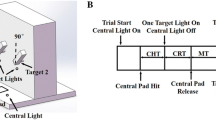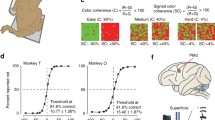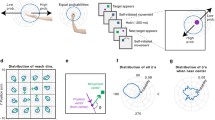Abstract
Motor and premotor cortex firing patterns from 307 single neurons were recorded while monkeys made rapid sequences of three reaching movements to remembered target buttons arrayed in two-dimensional space. A primary goal was to study and compare directionally tuned responses for each of three movement periods during 12 movement sequences that uniformly sampled the directional space in front of the monkey. The majority of neurons showed maximal responses during movements in a preferred direction with smaller increases during movements close to the preferred direction. These responses showed a statistically significant regression fit to a cosine function for 72% of the neurons examined. Comparisons among tuning directions computed separately for the first, second, and third movement periods suggested the near constancy of preferred direction across a rapidly executed series of movements even though these movements began at different starting points in space. Although directionally tuned neurons were only broadly tuned for a specific direction of movement, the neuronal ensemble carried accurate directional information. A population vector computed by summing vector contributions from the entire population of tuned neurons predicted movement direction with a mean accuracy of 20°. This population code made consistent predictions for each of the 36 movements that were studied using a single set of population parameters. Most of the remaining neurons (24%) that were not tuned during movement did show significant changes in activity during other aspects of task performance. Some nontuned neurons had nondirectional increases that were sustained during movement, while others showed identical phasic bursts during the three movement periods. These nontuned neurons may control stabilizations of the shoulder, trunk, and forearm during movement, or forearm movements during button pushing.
Similar content being viewed by others
References
Caminiti R, Johnson PB, Urbano A (1990) Making arm movements within different parts of space: dynamic aspects in the primate motor cortex. J Neurosci 10: 2039–2058
Caminiti R, Johnson PB, Galli C, Ferraina S, Burnod Y (1991) Making arm movements within different parts of space: the premotor and motor cortical representations of a coordinate system for reaching to visual targets. J Neurosci 11: 1182–1197
Cheney PD, Fetz EE (1980) Functional classes of primate corticomotoneuronal cells and their relation to active force. J Neurophysiol 44: 773–791
Clark MC, Marcario JK, Kettner RE (1991) Comparison of neuronal responses in the precentral cortex with EMG activity during an arm-movement sequence delay task. Soc Neurosci Abstr 16: 307
Conrad B, Wiesendander M, Matsunami K, Brooks VB (1977) Precentral unit activity related to control of arm movement. Exp Brain Res 29: 85–95
Crutcher MD, Alexander GE (1990) Movement-related neuronal activity selectively coding either direction or muscle pattern in three motor areas of the monkey. J Neurophysiol 64: 151–163
Dum RP, Strick PL (1991) The origin of corticospinal projections from the premotor areas of the frontal lobe. J Neurosci 11: 667–689
Evarts EV (1968) Relation of pyramidal tract activity to force exerted during voluntary movement. J Neurophysiol 32: 375–385
Evarts EV (1969) Activity of pyramidal tract neurons during postural fixation. J Neurophysiol 32: 375–385
Flanders M, Soechting JF (1990) Arm muscle activation for static forces in three-dimensional space. J Neurophysiol 64: 1818–1837
Fromm C, Wise SP, Evarts EV (1984) Sensory response properties of pyramidal tract neurons in the precentral motor cortex and postcentral gyrus of the rhesus monkey. Exp Brain Res 54: 177–185
Fu Q-G, Suarez JI, Ebner TJ (1993) Neuronal specification of direction and distance during reaching movements in the superior precentral premotor area and motor cortex of monkeys. J Neurophysiol 70: 2097–2116
Georgopoulos AP, Massey JT (1985) Static versus dynamic effects in motor cortex and area 5: comparison during movement time. Behav Brain Res 18: 159–166
Georgopoulos AP, Kalaska JF, Caminiti R, Massey JT (1982) On the relations between the direction of two-dimensional arm movements and cell discharge in primate motor cortex. J Neurosci 2: 1527–1537
Georgopoulos AP, Caminiti R, Kalaska JF, Massey JT (1983) Spatial coding of movement: a hypothesis concerning the coding of movement direction by motor cortical populations. Exp Brain Res [Suppl] 7: 327–336
Georgopoulos AP, Caminiti R, Kalaska JF (1984) Static spatial effects in motor cortex and area 5: quantitative relations in a two-dimensional space. Exp Brain Res 54: 446–454
Georgopoulos AP, Schwartz AB, Kettner RE (1986) Neuronal population coding of movement direction. Science 233: 1416–1419
Georgopoulos AP, Kettner RE, Schwartz AB (1988) Primate motor cortex and free arm movements to visual targets in threedimensional space. II. Coding of the direction of movement by a neuronal population. J Neurosci 8: 2928–2937
He S-Q, Dum RP, Strick PL (1993) Topographic organization of corticospinal projections from the frontal lobe: motor areas on the lateral surface of the hemisphere. J Neurosci 13: 952–980
Hepp-Reymond MC, Wyss UR, Anner R (1978) Neuronal coding of static force in the primate motor cortex. J Physiol (Paris) 74: 287–291
Huntley GW, Jones EG (1991) Relationship of intrinsic connections to forelimb movement representations in monkey motor cortex: a correlative anatomic and physiological study. J Neurophysiol 66: 390–413
Kalaska JF, Cohen DAD, Hyde ML, Prud'homme M (1989) A comparison of movement direction-related versus load direction-related activity in primate motor cortex using a two-dimensional reaching task. J Neurosci 9: 2080–2102
Kettner RE (1988) Population coding of directed arm movements in space by motor cortical neurons: mathematically sufficient conditions for accurate movement. Soc Neurosci Abstr 13: 343
Kettner RE, Marcario JK (1993) Directional properties of simultaneously-recorded neurons in primate prefrontal, premotor, and motor cortex. Soc Neurosci Abstr 18: 779
Kettner RE, Schwartz AB, Georgopoulos AP (1988) Primate motor cortex and free arm movements to visual targets in threedimensional space. III. Positional gradients and population coding of movement direction from various movement origins. J Neurosci 8: 2938–2947
Kettner R, Marcario J, Port N (1993) A neural network model of cortical activity during reaching. J Cogn Neurosci 5: 14–33
Kettner RE, Marcario JK, Port NF (1996) Control of remembered reaching sequences in monkey. II. Storage and preparation before movement in motor and premotor cortex. Exp Brain Res 112: 347–358
Kwan HC, MacKay WA, Murphy JT, Wong YC (1978) Spatial organization of precentral cortex in awake primates. II. Motor outputs. J Neurophysiol 41: 1120–1131
Marcario JK, Kettner RE, Clark MC (1991) Simultaneously recorded activity in motor and premotor cortices of monkey during arm-movement sequences. Soc Neurosci Abstr 16: 307
Miller LE, van Kan PLE, Sinkjaer T, Anderson T, Harris GD, Houk JC (1993) Correlation of primate red nucleus discharge with muscle activity during free-form arm movements. J Physiol (Lond) 469: 213–243
Murphy JT, Kwan HC, MacKay WA, Wong YC (1978) Spatial organization of precentral cortex in awake primates. III. Input-output coupling. J Neurophysiol 41: 1132–1139
Murphy JT, Wong YC, Kwan HC (1985) Sequential activation of neurons in primate motor cortex during unrestrained forelimb movement. J Neurophysiol 53: 435–445
Sanes JN Donoghue JP Thangaraj V Edelman RR Warach S (1995) Shared neural substrates controlling hand movements in human motor cortex. Science 268: 1775–1777
Schwartz AB (1992) Motor cortical activity during drawing movements: single-unit activity during sinusoidal tracing. J Neurophysiol 68: 528–541
Schwartz AB (1994) Direct cortical representation of drawing. Science 265: 540–542
Schwartz AB, Kettner RE, Georgopoulos AP (1988) Primate motor cortex and free arm movements to visual targets in threedimensional space. I. Relations between single cell discharge and direction of movement. J Neurosci 8: 2913–2927
Smith AM, Hepp-Reymond MC, Wyss UR (1975) Relation of activity in precentral cortical neurons to force and rate of force change during isometric contractions of finger muscles. Exp Brain Res 23: 315–332
Thatch WT (1978) Correlation of neural discharge with pattern and force of muscular activity joint position direction of intended next movement in motor cortex and cerebellum. J Neurophysiol 41: 654–676
Weinrich M, Wise SP (1982) The premotor cortex of the monkey. J Neurosci 2: 1329–1345
Wong YC, Kwan HC, MacKay WA, Murphy JT (1978) Spatial organization of precentral cortex in awake primates. I. Somatosensory inputs. J Neurophysiol 41: 1107–1119
Author information
Authors and Affiliations
Rights and permissions
About this article
Cite this article
Kettner, R.E., Marcario, J.K. & Clark-Phelps, M.C. Control of remembered reaching sequences in monkey. Exp Brain Res 112, 335–346 (1996). https://doi.org/10.1007/BF00227940
Received:
Accepted:
Issue Date:
DOI: https://doi.org/10.1007/BF00227940




